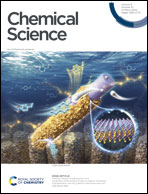Synergistic enhancement of electrocatalytic nitroarene hydrogenation over Mo2C@MoS2 heteronanorods with dual active-sites†
Abstract
Electrocatalytic hydrogenation (ECH) enables the sustainable production of chemicals under ambient conditions, in which catalysts catering for the different chemisorption of reactants/intermediates are desired but still challenging. Here, Mo2C@MoS2 heteronanorods with dual active-sites are developed to accomplish efficient nitroarene ECH according to our theoretical prediction that the binding of atomic H and nitro substrates would be synergistically strengthened on Mo2C–MoS2 interfaces. They afford high faradaic efficiency (>85%), yield (>78%) and selectivity (>99%) for the reduction of 4-nitrostyrene (4-NS) to 4-vinylaniline (4-VA) in neutral electrolytes, outperforming not only the single-component counterparts of Mo2C nanorods and MoS2 nanosheets, but also recently reported noble-metals. Accordingly, in situ Raman spectroscopy combined with electrochemical tests clarifies the rapid ECH of 4-NS on Mo2C–MoS2 interfaces due to the facilitated elementary steps, quickly refreshing active sites for continuous electrocatalysis. Mo2C@MoS2 further confirms efficient and selective ECH toward functional anilines with other well-retained reducible groups in wide substrate scope, underscoring the promise of dual-site engineering for exploring catalysts.

- This article is part of the themed collection: 2024 Chemical Science Covers


 Please wait while we load your content...
Please wait while we load your content...